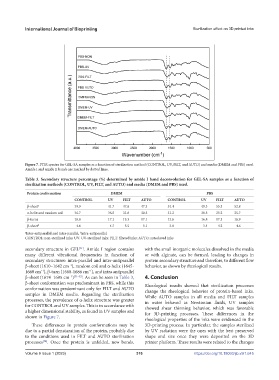Page 324 - IJB-9-1
P. 324
International Journal of Bioprinting Sterilization effect on 3D printed inks
Figure 7. FTIR spectra for GEL-SA samples as a function of sterilization method (CONTROL, UV, FILT, and AUTO) and media (DMEM and PBS) used.
Amide I and amide II bands are marked by dotted lines.
Table 3. Secondary structure percentage (%) determined by amide I band deconvolution for GEL-SA samples as a function of
sterilization methods (CONTROL, UV, FILT, and AUTO) and media (DMEM and PBS) used.
Protein conformation DMEM PBS
CONTROL UV FILT AUTO CONTROL UV FILT AUTO
β-sheet a 39.9 41.7 47.6 47.3 51.4 49.3 55.3 52.8
α-helix and random coil 36.7 36.5 31.6 30.5 31.2 30.5 25.2 25.7
β-turns 18.8 17.1 15.3 17.1 13.6 16.8 17.3 16.9
β-sheet b 4.6 4.7 5.5 5.1 3.8 3.4 4.2 4.6
a Inter-antiparallel and intra-parallel; intra-antiparallel.
b
CONTROL: non-sterilized inks; UV: UV-sterilized inks; FILT: filtered inks; AUTO: autoclaved inks
secondary structure in GEL . Amide I region contains with the small inorganic molecules dissolved in the media
[51]
many different vibrational frequencies in function of or with alginate, can be formed, leading to changes in
secondary structures: intra-parallel and inter-antiparallel protein secondary structure and therefore, to different flow
β-sheet (1610–1642 cm ), random coil and α-helix (1645- behavior, as shown by rheological results.
−1
1660 cm ), β-turn (1660-1686 cm ), and intra antiparallel
−1
−1
β-sheet (1674–1695 cm ) . As can be seen in Table 3, 4. Conclusion
−1 [51–53]
β-sheet conformation was predominant in PBS, while this Rheological results showed that sterilization processes
conformation was predominant only for FILT and AUTO change the rheological behavior of protein-based inks.
samples in DMEM media. Regarding the sterilization While AUTO samples in all media and FILT samples
processes, the prevalence of α-helix structure was greater in water behaved as Newtonian fluids, UV samples
for CONTROL and UV samples. This is in accordance with showed shear thinning behavior, which was favorable
a higher dimensional stability, as found in UV samples and for 3D-printing processes. These differences in the
shown in Figure 7. rheological properties of the inks were evidenced in the
These differences in protein conformations may be 3D-printing process. In particular, the samples sterilized
due to a partial denaturation of the protein, probably due by UV radiation were the ones with the best preserved
to the conditions used in FILT and AUTO sterilization shape and size once they were deposited on the 3D
processes . Once the protein is unfolded, new bonds, printer platform. These results were related to the changes
[54]
Volume 9 Issue 1 (2023) 316 https://doi.org/10.18063/ijb.v9i1.645

